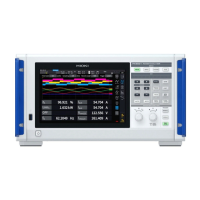42
Setting Wiring Mode and Conguring Current Sensor Settings
Wiring mode
1P2W
(single-phase 2-wire)
Select this wiring mode when measuring a DC line.
The current sensor can be connected to either the source or ground terminal.
The wiring diagrams include examples of both.
See “Wiring diagrams” (p. 48).
1P3W
(single-phase 3-wire)
—
3P3W2M
(3-phase 3-wire)
Select this wiring mode when using the two-wattmeter method with two channels to
measure a three-phase delta conguration.
It enables accurate measurement of active power even when waveforms are
distorted due to an unbalanced state.
Apparent power, reactive power, and power factor values for unbalanced lines may
dier from corresponding values obtained from other measuring instruments. In
such a case, use 3V3A or 3P3W3M wiring mode.
3V3A
(3-phase 3-wire)
Select this wiring mode when using the two-wattmeter method with three channels
to measure a three-phase delta conguration, which is used when you emphasize
compatibility with legacy power meters such as the Hioki 3193.
It allows accurate measurement of not only active power, but also apparent and
reactive power and power factor even with unbalanced lines.
3P3W3M
(3-phase 3-wire)
Select this wiring mode when using the three-wattmeter method with three
channels to measure a three-phase delta conguration.
It allows accurate measurement even if the instrument in 3V3A wiring mode
yields an error due to leakage current with large high-frequency component when
measuring a PWM inverter, making it well suited to motor power measurement.
3P4W
(3-phase 4-wire)
Select this wiring mode when using the three-wattmeter method with three
channels to measure a three-phase Y (star) conguration.
Current sensor auto-recognition function
The instrument automatically acquires the rated current, phase correction values, and other
information of the current sensor connected to the instrument.
This function can signicantly reduce the setting time before measurement, and measure the power
based on accurate sensor information.
(Only for current sensors supporting the auto-recognition function)
In the following cases, the instrument automatically acquires only the rated current of the current
sensor connected to the instrument.
• When a current sensor not equipped with the auto-recognition function is connected to the
instrument
• If the instrument fails to read current-sensor information, including phase correction values
List of optional current sensors
See “Optional products for current measurement” (p. 4).

